Table of Contents
Download PDF Version of this document. |
Table of Contents |
Refer to https://shop.trenz-electronic.de/en/Download/?path=Trenz_Electronic/carrier_boards/TE0701 for downloadable version of this manual and additional technical documentation of the product. |
The Trenz Electronic TE0701 Carrier Board is a baseboard for 4 x 5 SoMs, which exposes the module's B2B connector pins to accessible connectors and provides a whole range of on-board components to test and evaluate TE 4 x 5 SoMs.
See page "4 x 5 cm carriers" to get information about the SoMs supported by the TE0701 carrier board.
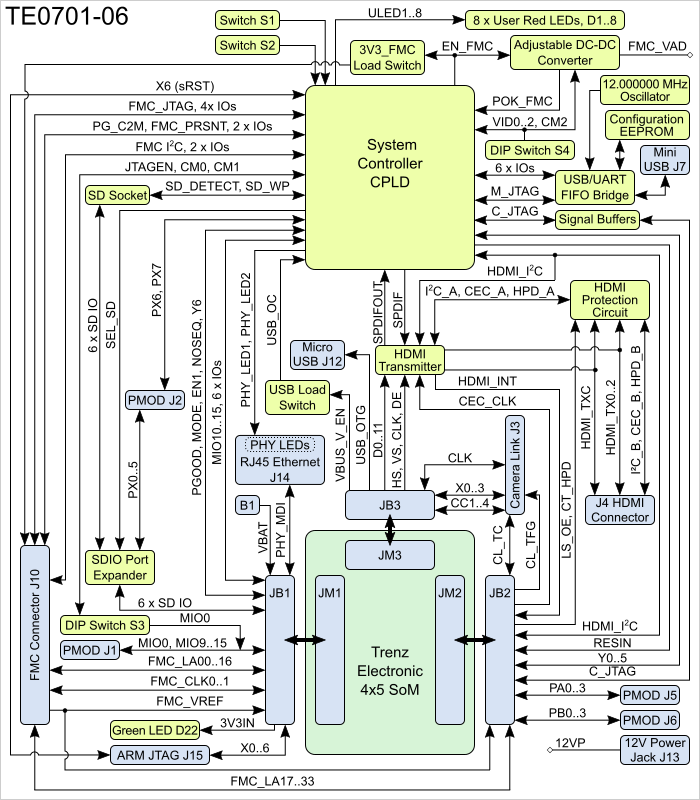
Figure 1: TE0701-06 block diagram.
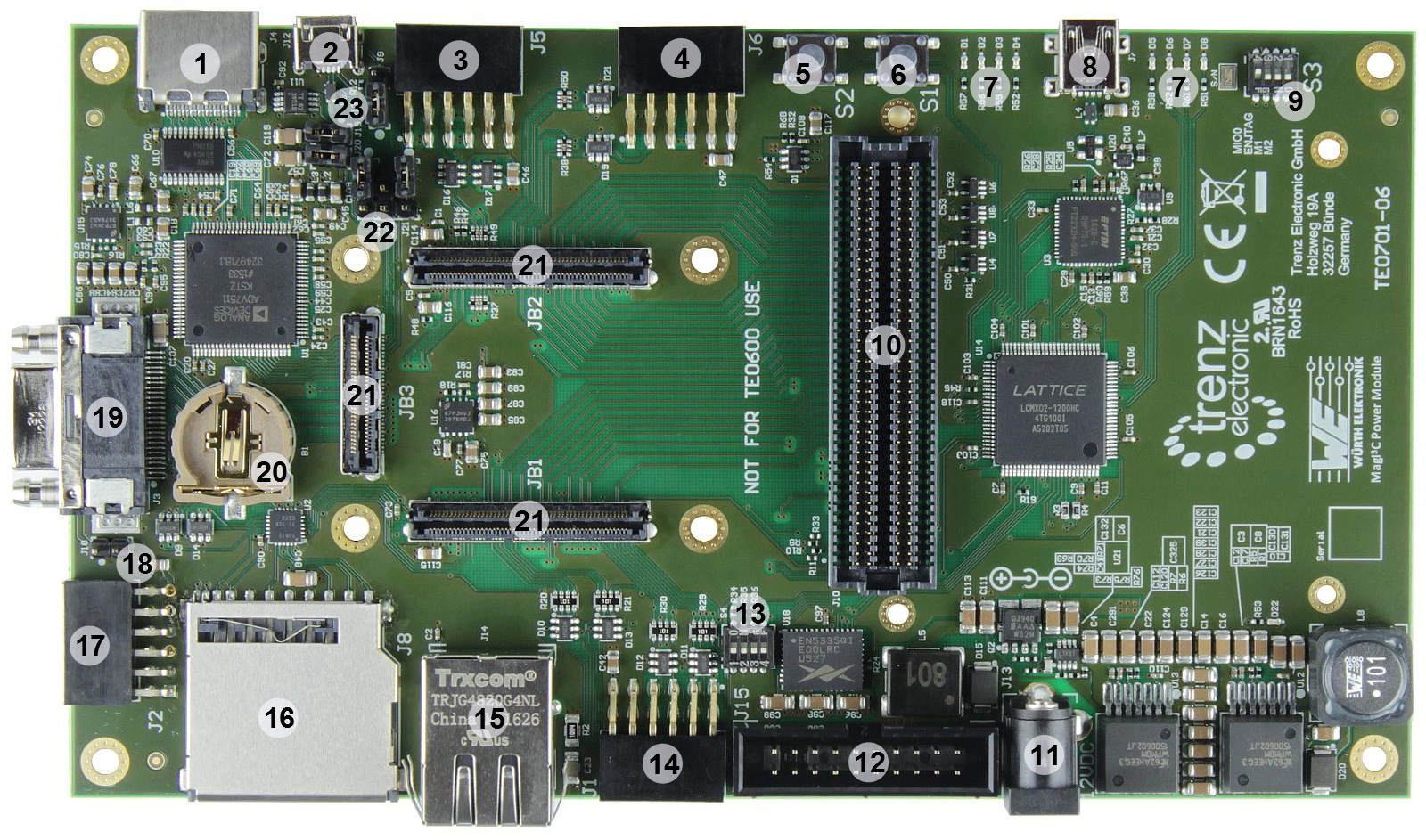
Figure 2: 4 x 5 SoM carrier board TE0701-06.
Pmod connector for access to Zynq module's PL IO-bank pins (4 LVDS pairs, max. VCCIO voltage: VIOTA)
Micro SD Card socket is not directly wired to the B2B connector pins, but through a Texas Instruments TXS02612 SDIO Port Expander, which is needed for voltage translation due to different voltage levels of the Micro SD Card and MIO-bank of the Xilinx Zynq module. The Micro SD Card has 3.3V signal voltage level, but the MIO-bank on the Xilinx Zynq module has VCCIO of 1.8V.
With SD_SEL signal connected to the Texas Instruments TXS02612 SDIO Port Expander user can choose which port is accessible. Port B0 is connected to the Micro SD Card connector and B1 is connected to the Pmod J2 connector. SD_SEL signal can be controlled by the System Controller CPLD firmware.
The TE0701 carrier board has on-board high-speed USB 2.0 to UART/FIFO IC FT2232HQ from FTDI. Channel A can be used as JTAG interface (MPSSE) to program the System Controller CPLD. Channel B can be used as UART interface routed to CPLD. Also 6 additional bus-lanes are connected to the System Controller CPLD and available for user-specific use.
There is also a 256-byte serial EEPROM connected to the FT2232H chip pre-programmed with license code to support Xilinx programming tools.
Do not access the FT2232H EEPROM using FTDI programming tools, doing so will erase normally invisible user EEPROM content and invalidate stored Xilinx JTAG license. Without this license the on-board JTAG will not be accessible any more with any Xilinx tools. Software tools from FTDI website do not warn or ask for confirmation before erasing user EEPROM content. |
The TE0701 carrier board has two physical USB connectors:
JTAG access to the System Controller CPLD and Xilinx Zynq module is provided via mini-USB JTAG interface J7 (FTDI FT2232H) and controlled by DIP switch S3-3.
The JTAG port of the System Controller CPLD is enabled by setting switch S3-3 ENJTAG to the OFF position.
There are eight LEDs (ULED1 to ULED8) available to the user. All LEDs are red colored and connected to the on-board System Controller CPLD. Their function ls programmable and depend on the firmware of the System Controller CPLD. For detailed information, please refer to the documentation of the TE0701 System Controller CPLD.
LED5 (D5) to LED8 (D8) are operating only when the corresponding power supply VIOTB (i.e., bank 1 of the on-board System Controller CPLD) is switched on. This can be accomplished by connecting the FMC power supply FMC_VADJ to VIOTB (J21: 1,2-3), which is the default option, or by connecting either 2.5V (J17: 1,2-3) or 3.3V (J17: 1-2,3) to VIOTB (J21: 1-2,3). Please note that for the first default option, the FMC power supply voltage must be set by the user. For detailed information how to set the voltage FMC_VADJ via I2C, please refer to the documentation of the TE0701 System Controller CPLD. |
Green LED D22 indicates presence of 3.3V power from the SoM attached.
There is a 4-bit DIP-switch S3 with following default settings:
| Switch | Functionality |
|---|---|
| S3-1 | CM1: Mode pin 1 (routed to System Controller CPLD). |
| S3-2 | CM0: Mode pin 0 (routed to System Controller CPLD). |
| S3-3 | JTAGEN: Set to ON for normal JTAG operation. Has to be set to OFF position for System Controller CPLD JTAG access. |
| S3-4 | MIO0: Pin from/to JB1-88 and PMOD (J1) connector. Direction depends on Module FPGA/SoC configuration. |
Table 1: DIP-switch S3 settings.
On the TE0701 Carrier Board there are two push-buttons (S1 and S2) and are routed to the System Controller CPLD and available to the user. The default mapping of the push-buttons is as follows:
| Name | Default Mapping: |
|---|---|
| S1 | Custom Button functionality CPLD Firmware dependent. |
| S2 | If S2 is pushed, the active-high Power ON (PON) signal (that is internally pulled-up) will be de-asserted, which can be considered as a "RESTART" function as all on-module power supplies will be switched off (except 3.3VIN) on button push and back on again on button release. The active-high PON signal is directly mapped to the active-high EN1 signal which is routed to the module's System Controller CPLD (e.g., on the TE0720) and directly used as a mandatory active-high enable signal to the power FET switch, enabling on-module 3.3V power supply output as well as all other DC-DC converters on the module. |
Table 2: Description of default functions of user push-buttons S1 and S2.
The function of the push-buttons depend on the System Controller CPLD firmware. For detailed information of the function of the push-buttons, please refer to the documentation of the TE0701 System Controller CPLD.
The TE0701 Carrier Board has a RJ45 Gigabit Ethernet MagJack (J14) with two LEDs. On-board Ethernet MagJack J14 pins are routed to B2B connector JB1 via MDI. The center tap of the magnetics is not connected to module's B2B connector. PHY LEDs are not connected directly to the module's B2B connectors as the 4 x 5 module have no dedicated PHY LED pins assigned. PHY LEDs are connected to the TE0701 System Controller CPLD and can be routed to some of the module's I/O pins with firmware.
See documentation of the TE0701 System Controller CPLD to get information of the function of the PHY LEDs.
J5 and J6 Pmod signal routing is done as differential pairs for pins 1-2, 3-4, 7-8 and 9-10.
Please use Master Pin-out Table table as primary reference for the pin mapping information.
J5 and J6 are incompatible with dual PMODs, because they have different PMOD connector offset and variable (different) VCCIO voltage. |
Power supply with minimum current capability of 3A at 12V for system startup is recommended.
The on-board voltages 3.3V and 5.0V of the carrier board will be brought up simultaneously when 12V power supply is connected to the barrel jack J10.
The on-board voltages 1.8V and 2.5V will be brought up when module's 3.3V voltage level has become stable and 3.3VOUT is available on the B2B connector JB2 pins 9 and 11.
The PL IO-bank supply voltage FMC_VADJ will be available after the output of the 5.0V DC-DC converter is active and the pin EN_FMC of the System Controller CPLD is asserted.
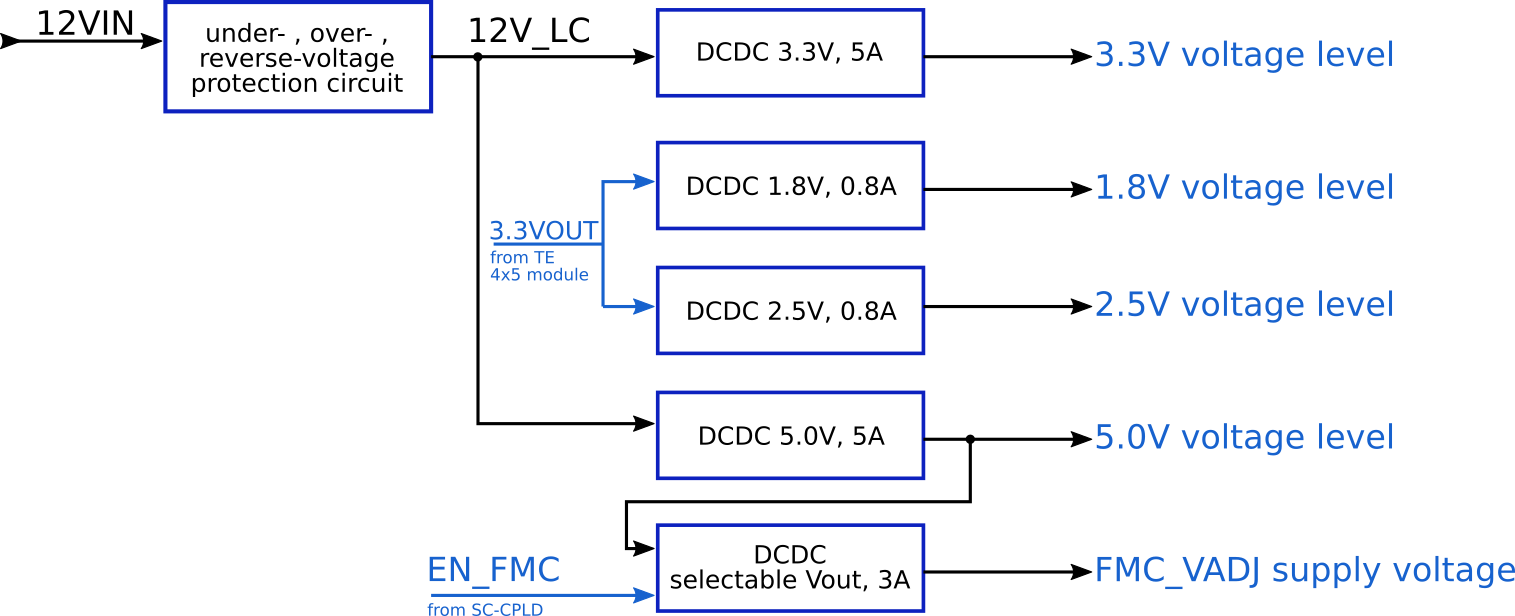
Figure 3: TE0701-06 power-up sequence diagram.
On the TE0701 carrier board different VCCIO configurations can be chosen by 7 jumpers and one dedicated 4-bit DIP-switch S4. Settings of the jumpers and the DIP-switch S4 are explained below.
The baseboard supply voltages for the PL IO-banks of the SoM are selectable by the jumpers J16, J17 and J21. The DIP-switch S4 sets the adjustable baseboard supply-voltage FMC_VADJ.
There is also option to select fixed voltage of FMC_VADJ with DIP-switch S4. In this case there is no need to configure the 8-bit control register of the I2C-to-GPIO-module of the System Controller CPLD. Switch S4 is also routed to the System Controller CPLD, hence the VCCIO configuration can be registered by the CPLD. Switch S4-4 is not dedicated for FMC_VADJ setting, the function of this switch depends on the System Controller CPLD firmware. |
Table 3 below describes switch S4 settings for different FMC_VADJ voltages.
| S4-1 | S4-2 | S4-3 | FMC_VADJ Value |
|---|---|---|---|
| ON | ON | ON | 3.3V |
| OFF | ON | ON | 2.5V |
| ON | OFF | ON | 1.8V |
| OFF | OFF | ON | 1.5V |
| ON | ON | OFF | 1.25V |
| OFF | OFF | OFF | Attention: Set VADJ to S3-M1 and S3-M2 control, read TE0701 System Controller CPLD description, before this mode is used! |
Table 3: Switch S4 positions for fixed values of the FMC_VADJ voltage.
The supply-voltage FMC_VADJ is user programmable via I2C. Configuration of the adjustable voltage FMC_VADJ is done over dedicated I2C bus (lines HDMI_SCL and HDMI_SDA). A control byte has to be sent to the 8-bit control register of the I2C-to-GPIO module of the System Controller CPLD. This modules I2C address is 0x22. To enable FMC_VADJ on TE0701, bit 7 of the control register should be set to 1. Note that the I2C bus is shared with the I2C interface of the HDMI Controller. For detailed information how to set the voltage FMC_VADJ via I2C, please refer to the documentation of the TE0701 System Controller CPLD. |
12V power supply can be connected to pin 26 of the CameraLink by closing J18. However, this option is disabled by default (J18: OPEN).
The TE0701 carrier board can be configured as a USB host. Hence, it must provide from 5.25V to 4.75V to the board side of the downstream connection (micro-USB port on J12; 13). To provide sufficient power, a TPS2051 power distribution switch is located on the carrier board in between the 5V power supply and the VBUS signal of the USB downstream port interface. If the output load exceeds the current-limit threshold, the TPS2051 limits the output current and pulls the over-current logic output (OC_n) low, which is routed to the on-board CPLD. The TPS2051 is put into operation by setting J19 CLOSED. J20 provides an extra 100µF decoupling capacitor (in addition to 10µF) to further stabilize the output signal. Moreover, a series terminating resistor of either 1K (J9: 1-2, 3) or 10K (J9: 1, 2-3) is selectable on the "USB-VBUS" signal. Both signals, USB-VBUS and VBUS_V_EN (that enables the TPS2051 on "high") are routed (as well as the corresponding D+/- data lines) via the on-board connector directly to the USB 2.0 high-speed transceiver PHY on the mounted SoM, which is, in turn, connected to the Zynq FPGA. In summary, the default jumper settings are the following: J9: 1-2, 3 (1K series terminating resistor); J19: CLOSED (TPS2051 in operation); J20: CLOSED (100 µF added).
Additionally, the TE0701 carrier board is equipped with a second mini-USB port (J7) which is connected to a USB to multi-purpose UART/FIFO IC from FTDI (FT2232HQ) and provides a USB to JTAG interface between a host PC and the TE0701 carrier board and the Zynq module. Because it acts as a USB function device, no power switch is required (and only a ESD protection must be provided) in this case.
There are two baseboard supply voltages VIOTA and VIOTB connected to the 4 x 5 SoM's PL IO-bank. The supply-voltages have following pin assignments on B2B-connectors:
Baseboard supply voltages | Baseboard B2B connector-pins | Standard assignment of PL IO-bank supply voltages on TE 4 x 5 module's B2B connectors | Baseboard voltages and signals connected with |
|---|---|---|---|
| VIOTA | JB2-2, JB2-4, JB2-6 | VCCIOB (JM2-1, JM2-3) / VCCIOC (JM2-5) | HDMI_SCL, HDMI_SDA, HDMI_INT, J5 VCCIO |
| VIOTB | JB1-10, JB1-12, JB2-8, JB2-10 | VCCIOA (JM1-9, JM1-11) / VCCIOD (JM2-7, JM2-9) | VCCIO1 (System Controller CPLD pin 55, 73) |
Table 4: Baseboard supply-voltages VIOTA and VIOTB
Note: The corresponding PL IO-voltage supply voltages of the 4 x 5 SoM to the selectable baseboard voltages VIOTA and VIOTB are depending on the mounted 4 x 5 SoM and varying in order of the used model. Refer to SoM's schematics for more information about the specific pin assignment on module's B2B-connectors regarding PL IO-bank supply voltages and to the 4 x 5 Module integration Guide for VCCIO voltage options. |
Following table describes how to configure the baseboard supply voltages with jumpers.
Baseboard supply voltages vs voltage levels | VIOTA | VIOTB | USB-VBUS | 12V0_CL |
|---|---|---|---|---|
| 3V3 | J17: 1-2, 3 & J16: open | J17: 1-2, 3 & J16: open & J21: 1-2, 3 | - | - |
| 2V5 | J17: 1, 2-3 & J16: open | J17: 1, 2-3 & J16: open & J21: 1-2, 3 | - | - |
| FMC_VADJ | J17: open & J16: 1-2 | J21: 1, 2-3 | - | - |
| 5V0 intern | - | - | J9: 1-2, 3 & J19: 1-2 (J20: 1-2: additional decoupling-capacitor 100 µF) | - |
| VBUS extern | - | - | J9: 1, 2-3 & J19: open | - |
| 12V_LC | - | - | - | J18: 1-2 |
Table 5: Configuration of baseboard supply-voltages via jumpers. 'Jx: 1-2, 3' means pins 1 and 2 are closed, pin 3 is open. 'Jx: 1, 2-3' means pins 2 and 3 are closed, pin 1 is open.
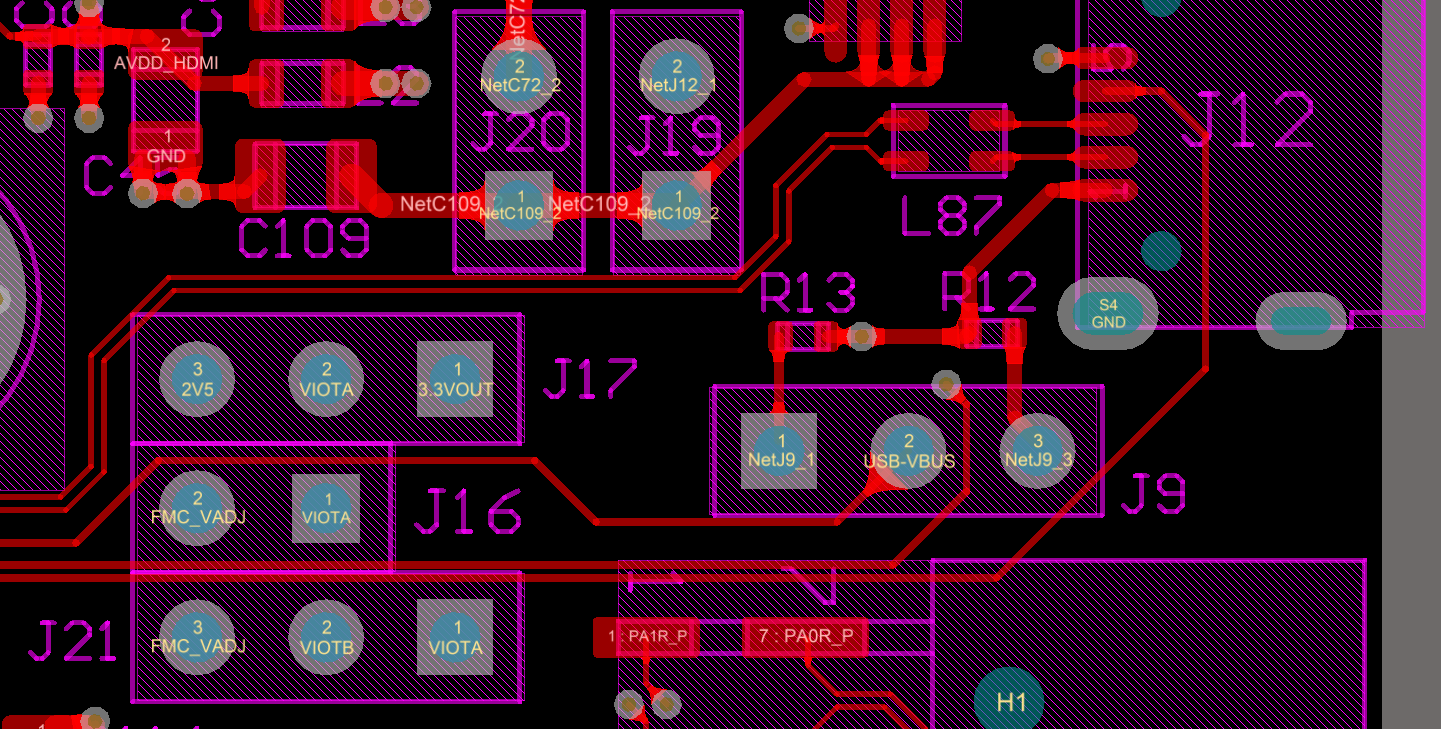
Figure 4: VCCIO jumper pin location (PCB-REV06), top view.
Take care of the VCCO voltage ranges of the particular PL IO-banks (HR, HP) of the mounted SoM, otherwise damages may occur to the FPGA. Therefore, refer to the TRM of the mounted SoM to get the specific information of the voltage ranges. It is recommended to set and measure the PL IO-bank supply-voltages before mounting of TE 4 x 5 module to avoid failures and damages to the functionality of the mounted SoM. |
| Parameter | Min | Max | Units | Notes |
|---|---|---|---|---|
VIN supply voltage | 11.4 | 12.6 | V | ANSI/VITA 57.1 FPGA Mezzanine Card (FMC) standard |
Storage temperature | -55 | 125 | °C | - |
| Parameter | Min | Max | Units | Notes |
|---|---|---|---|---|
| VIN supply voltage | 11.4 | 12.6 | V | - |
Board size: PCB 170.4 mm × 98 mm. Notice that some parts the are hanging slightly over the edge of the PCB like the mini-USB jacks (ca. 1.4 mm), the Ethernet RJ-45 jack (ca 2.2 mm) and the mini CameraLink connector (ca. 7 mm), which determine the total physical dimensions of the carrier board. Please download the assembly diagram for exact numbers.
Mating height of the module with standard connectors is 8mm.
PCB thickness: ca. 1.65mm.
Highest part on the PCB is the Ethernet RJ-45 jack, which has an approximately 17 mm overall height. Please download the step model for exact numbers.
All dimensions are given in millimeters.
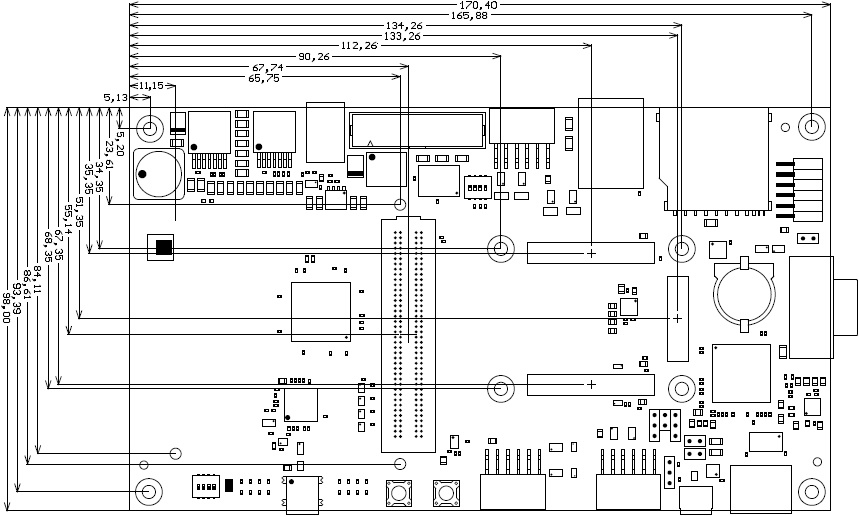
Figure 5: Physical dimensions of the TE0701-06 carrier board.
Commercial grade: 0°C to +70°C.
Board operating temperature range depends also on customer design and cooling solution. Please contact us for options.
ca. 188 g - Plain board.
| Date | Revision | Authors | Description |
|---|---|---|---|
| John Hartfiel |
| ||
| 2017-11-09 | v.60 | John Hartfiel |
|
| 2017-08-15 | v.59 | John Hartfiel |
|
| 2017-08-14 | v.58 | John Hartfiel |
|
| 2017-05-25 | v.56 | Jan Kumann |
|
| 2017-05-16 | v.51 | Jan Kumann |
|
| 2017-04-11 | Ali Naseri |
| |
| 2017-02-15 | v.45 | Ali Naseri |
|
| 2017-02-15 | v.40 | Ali Naseri |
|
| 2017-01-19 | v.35 | Ali Naseri |
|
| 2017-01-13 | v.20 | Ali Naseri |
|
| 2016-11-29 | v.10 | Ali Naseri |
|
| 2016-11-28 | v.4 | Ali Naseri |
|
| 2014-02-18 | 0.2 | Sven-Ole Voigt |
|
| 2014-01-05 | 0.1 | Sven-Ole Voigt |
|
| All | Sven-Ole Voigt, Ali Naseri |
| Date | Revision | Notes | PCN | Documentation link |
|---|---|---|---|---|
| - | 06 | Additional Jumper J16 and switch S4 for setting VCCIO FMC_VADJ. | PCN-20161128 | |
| - | 05 | Improved manufacturing | TRM-TE0701-05 | |
| - | 04 | |||
| - | 03 | Changed DC/DC converters | ||
| - | 02 | Prototype | ||
| - | 01 | Prototype |

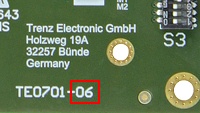
Figure 5: Hardware revision number.
Hardware revision number is printed on the PCB board next to the module model number separated by the dash.